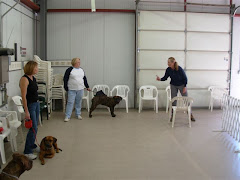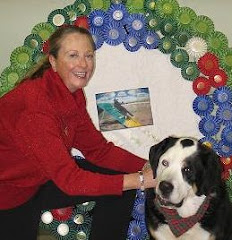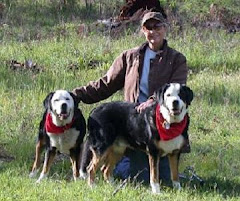 Photo: Note the Dobie's stomach is distended. This is a painful, life-threatening emergency.
Photo: Note the Dobie's stomach is distended. This is a painful, life-threatening emergency.If you have a Great Dane, Bloodhound, Standard Poodle, Rottweiler, German Shepherd, Irish Wolfhound, Doberman, Boxer, Mastiff, Malamute, Akita, Borzoi, Greater Swiss Mountain Dog, St. Bernard, Labrador, Bernese Mountain Dog, or any other breed of dog with a deep chest (which could include Golden Retrievers, Shorthairs, Dalmations and many others), you need to know about an all-too-common killer of your breeds.
It's called GDV...Gastric Dilatation Volvulus...also known as "bloat."
Actually, "bloat" is what happens immediately before GDV. Let's say your deep-chested dog ingests a lot of food, water, air, or combination of these three. He gets gassy. The stomach swells up just like yours does after eating too much of the "wrong" food. That's the "bloat" part. The situation becomes life-threatening to your dog when it goes one step farther. The bloated stomach twists clockwise, and the tubes leading into and out of the stomach kink. Nothing can pass. Pain is great, and death is imminent, since blood and oxygen are cut off to the vital organs.
It's the Number One Killer of Great Danes. Nearly half of Danes will bloat. Chances are, you know someone whose dog has bloated and died. My dog Atlas, a Greater Swiss Mountain Dog, died of GDV just a year ago, at the age of 12. I know two Labs who bloated...and one died. I can think of countless other dogs who've either bloated or gone full-blown GDV. About half of them died.
If you have a dog with a genetic tendency to bloat, KNOW THE SIGNS:
1. The dog comes to you with a distressed look.
2. Breathing is rapid and shallow.
3. Dog tries to vomit and defecate, and can't do either.
4. Abdomen begins to expand. It gets hard and tight like a drum.
5. Dog can't find a comfortable position.
6. Dog begins to show signs of shock (looks and acts lethargic or agitated, eyes get glassy, gums get pale and dry, breathing is labored, pulse is rapid and shallow.
If you see any of these signs, contact a vet at once. This is a life-threatening emergency. You must get your dog to a vet immediately.
The vet will determine whether or not the stomach has actually twisted, or "torsed," on its axis. If it hasn't, that's good. Your vet will perform procedures to release the gas in your dog's abdomen, and the prognosis is generally good. If the stomach has flipped, however, emergency abdominal surgery is necessary to turn the stomach back into place. Many vets will then tack the stomach in place, drastically reducing the chance of recurrence. Dog owners must follow through with lifelong management of their dogs' "condition." They must take precautions with the dog's physical activities and with his diet.
How to avoid GDV:
There are no foolproof ways to avoid a case of GDV in your dog. But many owners of GDV-prone dogs believe the following steps are helpful:
1. Feed smaller meals more frequently. Feed at least 3 times a day.
2. Find a way to reduce the amount of air the dog swallows as he eats. Raise the dish, put a rock or other obstruction (like a choke chain) in the dish, atop the food. This will slow the dog's eating.
3. Don't feed a dog who is still panting from heavy exercise.
4. Rest your dog for a few minutes after he eats.
5. Add Mylanta or an acid reducer to your dog's food if he frequently has gastric difficulties.
Preventive Surgery:
If you own one of the breeds that is frequently afflicted with bloat and GDV, you can choose elective surgery to tack the stomach in place BEFORE the dog bloats. The surgery is frequently performed at veterinary teaching hospitals (like WSU in Pullman), and is minimally invasive, meaning the recovery is fairly easy and the cost is affordable. The cost of a "lapro-pexy," as it's called, is a fraction of the cost of GDV emergency surgery.
For more on the subject, click on the link below, which will take you to details and photos, and explain in details the procedure for treating GDV.
http://www.google.com/imgres?imgurl=http://www.vetsurgerycentral.com/images/gastrointestinal/GDV/gdv1.jpg&imgrefurl=http://www.vetsurgerycentral.com/gdv.htm&usg=__iUn5Frpceyw188WDEmt23Cp4PeM=&h=307&w=410&sz=13&hl=en&start=7&sig2=cW3tPp3YIH5-rKt1OjAj3g&tbnid=IAaslkZbEjHZ-M:&tbnh=94&tbnw=125&ei=zpOQScCqJ5K2sQP3nczbCA&prev=/images%3Fq%3DGDV%2Bphoto%26hl%3Den


















1 comment:
Jan,
I don't know if you knew, but Shadow, our Weimaraner, bloated last summer. You know how people focused she is with us, so I didn't think anything about it right away, she just kept coming up to me like she wanted to go outside. What I couldn't figure out is that the back door was open because it was finally a cool night and I wanted the fresh air. She kept trying to vomit and only saliva came out. She's always anxious near meal time, and Loren was at work, so I kind of figured she was being her neurotic self. It was near dark, with a dark dog, so it wasn't until she came back inside again that I noticed from her profile that her belly was swollen. Loren pulled into the driveway right at that moment. We called the local pet ER and we were in town in less than 30 minutes from when I noticed. We were frantic, knowing what you've taught us and what we've read. (It didn't help that I had just finished Marley and Me!) The vet and techs there were so calm and took such good care of her and us. They had her in surgery by 10 p.m. This all started about 8:30 p.m. She made it out just fine and is back to keeping us on our toes. Thank you for teaching us the signs. I am emailing you a photo of her staples. Feel free to use it.
Joy, Loren and Shadow Ogilvie
Post a Comment